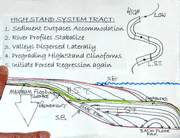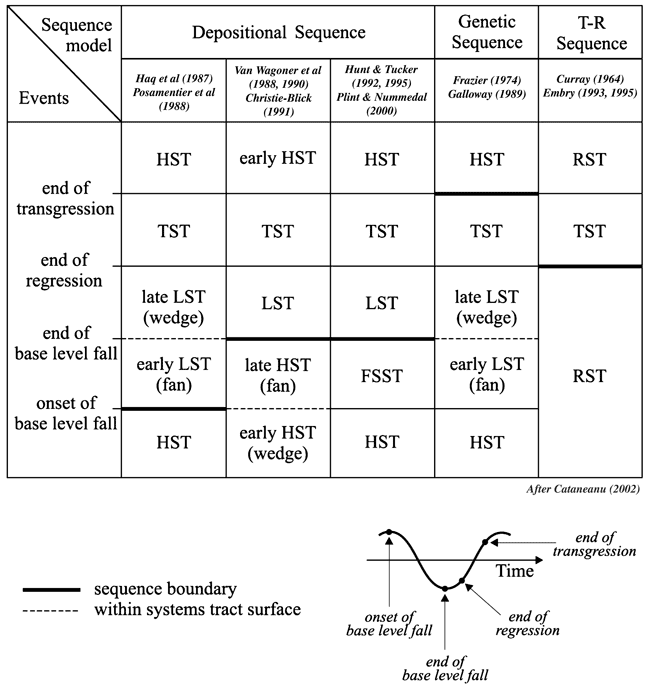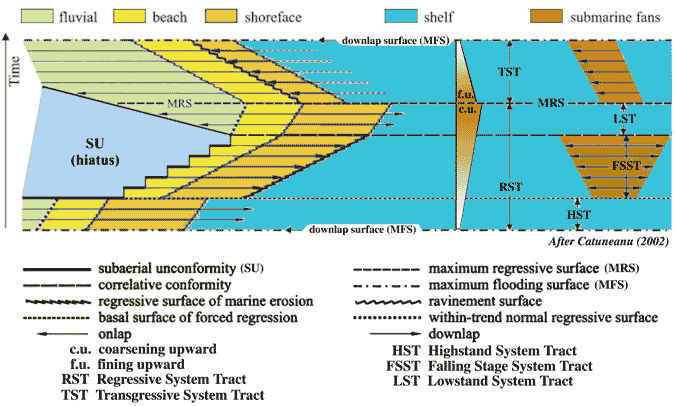|
base level


|

depositional sequence
The boundaries of depositional sequences include a combination of subaerial unconformities that are the classic "sequence boundaries" of Vail et al (1977), and their marine correlative conformity. Catuneanu (2002) equates the timing of this subaerial unconformity with a stage in the base level fall at the shoreline. He explains how Haq et al, (1987) and Posamentier et al. (1988) match the correlative conformity with the sea floor at the start of a forced regression. In contrast Van Wagoner et al. (1988, 1990) and Christie-Blick (1991) match this to the sea floor at the end of a forced regression. Hunt and Tucker (1992, 1995) and Plint and Nummendal (2000) agree but introduce the concept of and terminology of the Falling Stage systems tract that matches the period of forced regression.
The concepts associated with the depositional sequence model are important in that the correlative conformity can be considered as a chronostratigraphic marker. The problem is that a correlative conformity of the shallow marine portion in most outcrops, cores, or on wireline logs is difficult to identify though it can be inferred from seismic data (Catuneanu, 2002). However that in deep marine settings, the correlative conformity is relatively easy to identify beneath falling stage submarine fan systems (Catuneanu, 2002).
The genetic stratigraphic sequence
The genetic stratigraphic sequence of Galloway (1989) uses maximum flooding surfaces as sequence boundaries. He indicates that this lies between the transgreesive system tract and that of the highstand. He also equates the lowstand sytem tract with a relative fall and early rise. Catuneanu (2002) points out the importance of the maximum flooding surfaces is tied to the ease with which it can be mapped across a basin. On the down side the maximum flooding surface may be diachronous (Posamentier and Allen, 1999) and Catuneanu (2002) suggest that genetic sequences have subaerial unconformities within the sequence which potentially cross from one ‘‘genetic'' package to a completely unrelated one.
The transgressive-regressive sequence (T-R sequence)
The transgressive-regressive sequence (T-R sequence) of Embry and Johannessen (1992) is enveloped by "composite surfaces" that include subaerial unconformities and/or ravinement surfaces and their correlative maximum regressive surfaces (Catuneanu, 2002). Catuneanu (2002) suggests that the "T-R sequence has more utility than the depositional and genetic stratigraphic sequences". He indicates the "correlative conformity is replaced with the marine portion of the maximum regressive surface." He believes that the "latter surface has the advantage of being recognizable in shallow marine settings of virtually any type of outcrop." The problem with this approach is that nonmarine and marine portions of the sequence boundary (the subaerial unconformity and the maximum regressive surface respectively) are potentially diachronous and may also be mixed with the ravinement surface.

References Cited
Catuneanu, Octavian (2002), Sequence stratigraphy of clastic systems: concepts, merits, and pitfalls Journal of African Earth Sciences, Volume 35, Issue 1, Pages 1-43
Christie-Blick, N., 1991, Onlap, offlap, and the origin of unconformity bounded depositional sequences. Marine Geology 97, 35–56.
Curray, J.R., 1964, Transgressions and regressions. In: Miller, R.L. (Ed.), Papers in Marine Geology. Macmillan, New York, pp. 175– 203.
Embry, A.F., 1993, Transgressive–regressive (T–R) sequence analysis of the Jurassic succession of the Sverdrup basin, Canadian Arctic Archipelago. Canadian Journal of Earth Sciences 30, 301–320.
Embry, A.F., 1995, Sequence boundaries and sequence hierarchies: problems and proposals. In: Steel, R.J., Felt, V.L., Johannessen, E.P., Mathieu, C. (Eds.), Sequence stratigraphy on the Northwest European Margin, vol. 5 (Special Publication). Norwegian Petroleum Society (NPF), pp. 1–11.
Embry, A.F., Johannessen, E.P., 1992, T–R sequence stratigraphy, facies analysis and reservoir distribution in the uppermost Triassic- Lower Jurassic succession, western Sverdrup basin, Arctic Canada. In: Vorren, T.O., Bergsager, E., Dahl-Stamnes, O.A., Holter, E., Johansen, B., Lie, E., Lund, T.B. (Eds.), Arctic Geology and Petroleum Potential, vol. 2 (Special Publication). Norwegian Petroleum Society (NPF), pp. 121–146.
Frazier, D.E., 1974, Depositional episodes: their relationship to the Quaternary stratigraphic framework in the northwestern portion of the Gulf Basin. Geological Circular, vol. 1, no. 1. University of Texas at Austin, Bureau of Economic Geology, p. 28.
Galloway, W.E., 1989, Genetic stratigraphic sequences in basin analysis. I. Architecture and genesis of flooding-surface bounded depositional units. American Association of Petroleum Geologists Bulletin 73, 125–142.
Haq, B.U., Hardenbol, J., Vail, P.R., 1987, Chronology of fluctuating sea levels since the Triassic. Science 235, 1156–1166.
Hunt, D., Tucker, M.E., 1992, Stranded parasequences and the forced regressive wedge systems tract: deposition during base-level fall. Sedimentary Geology 81, 1–9.
Hunt, D., Tucker, M.E., 1995,Stranded parasequences and the forced regressive wedge systems tract: deposition during base-level fall––reply. Sedimentary Geology 95, 147–160.
Plint, A.G., Nummedal, D., 2000, The falling stage systems tract: recognition and importance in sequence stratigraphic analysis. In: Hunt, D., Gawthorpe, R.L. (Eds.), Sedimentary Response to forced regression, vol. 172. Geol. Soc. London Speci. Publ, pp. 1–17.
Pomar, L., 1991, Reef geometries, erosion surfaces and high frequency sea level changes, Upper Miocene Reef Complex, Mallorca, Spain: Sedimentology, v. 38, p. 243–269.
Posamentier, H.W., Allen, G.P., 1999. Siliciclastic sequence stratigraphy: concepts and applications. SEPM Concepts in Sedimentology and Paleontology no. 7, 210 p
Posamentier, H.W., Jervey, M.T., Vail, P.R., 1988, eustatic controls on clastic deposition. I. Conceptual framework. In: Wilgus, C.K., Hastings, B.S., Kendall, C.G.St.C., Posamentier, H.W., Ross, C.A., Van Wagoner, J.C. (Eds.), Sea Level Changes––An Integrated Approach, vol. 42. SEPM Special Publication, pp. 110– 124.
Vail, P. R. , R. G. Todd,and J. B. Sangree, 1977, Seismic Stratigraphy and Global Changes of Sea Level: Part 5. Chronostratigraphic Significance of Seismic Reflections: Section 2. Application of Seismic Reflection Configuration to Stratigraphic Interpretation Memoir 26, Pages 99 – 116.
Van Wagoner, J.C., Posamentier, H.W., Mitchum, R.M., Vail, P.R., Sarg, J.F., Loutit, T.S., Hardenbol, J., 1988, An overview of sequence stratigraphy and key definitions. In: Wilgus, C.K., Hastings, B.S., Kendall, C.G.St.C., Posamentier, H.W., Ross, C.A., Van Wagoner, J.C. (Eds.), Sea Level Changes––An Integrated Approach, vol. 42. SEPM Special Publication, pp. 39–45.
Van Wagoner, J.C., Mitchum Jr., R.M., Campion, K.M., Rahmanian, V.D., 1990, Siliciclastic sequence stratigraphy in well logs, core, and outcrops: concepts for high-resolution correlation of time and facies. American Association of Petroleum Geologists Methods in Exploration Series 7, 55 pp.
|